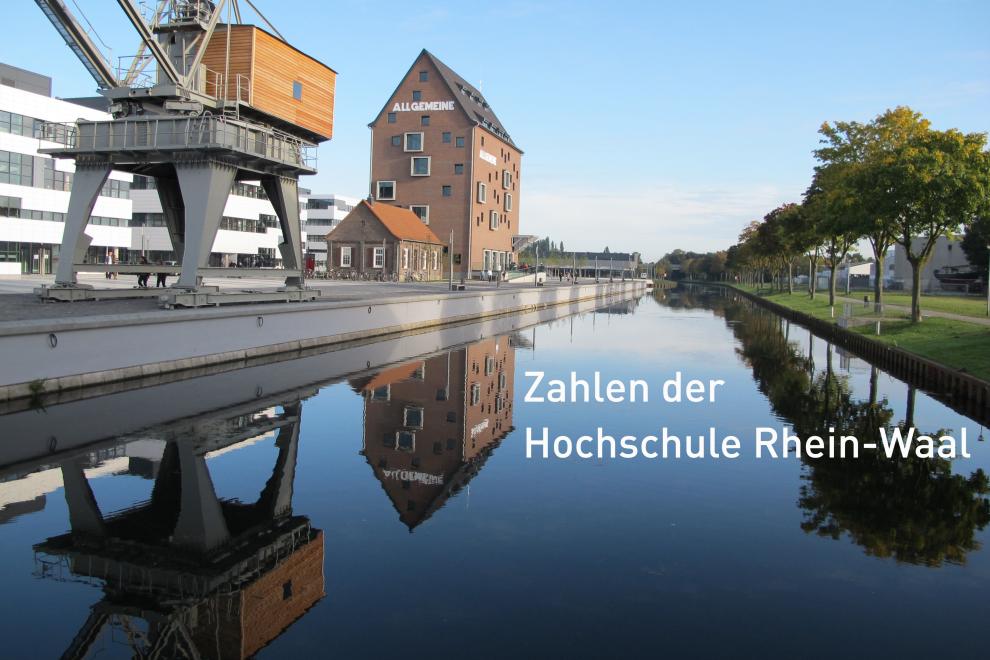Rhine-Waal University of Applied Sciences in numbers
Since being founded in 2009, Rhine-Waal University of Applied Sciences has continuously developed and strengthened its signature character as an international space of teaching and learning. According to newly released figures, 7,390 young people were in enrolled at this interdisciplinary and international university in the previous winter semester. Fifty-three per cent are international students and 45 per cent are women.
Since its founding in 2009, Rhine-Waal University of Applied Sciences (HSRW) has continuously developed and strengthened its signature character as an international environment of teaching and learning at both campus locations in Kleve and Kamp-Lintfort. “All this occurred during a time of tremendous growth over the past few years. Additional measures initiated by the German federal government only amplified this growth. These figures need to be seen within this context to be fully understood,” explained President Dr Oliver Locker-Grütjen.
The facts and figures revealed by the newly published report focus primarily on the areas of teaching and staff at Rhine-Waal University and thus do not provide an all-encompassing look. Data was gathered by the University’s internal controlling team. A detailed understanding of statistical surveying methods is required to properly interpret the figures as well. The report offers an initial quantitative snapshot of Rhine-Waal University that can be used to find jumping-off points and anomalies for further qualitative investigation. The ongoing coronavirus pandemic will surely have an unusual impact on future figures – as well as those of other institutions – and complicate efforts to interpret them.
The degree programmes offered by Rhine-Waal University are deeply international and interdisciplinary. A large part of what makes these programmes so attractive for international audiences in particular is the language they are taught in: 75 per cent are offered entirely in English. Consistently large enrolment numbers – around 1,950 new students per year since 2016 – is another indication of Rhine-Waal University’s continued appeal.
After an initial period of swift growth following its founding, total student enrolment has since levelled off for the past three years at around 7,350 students. This remains significantly above the numbers envisioned by original planning. Noteworthy is the proportionally uneven distribution of students in the Faculties of Life Sciences and Technology and Bionics compared to the Faculties of Society and Economics and Communication and Environment.
The composition of the student body clearly demonstrates the international profile of Rhine-Waal University. Fifty-three per cent of students originate outside of Germany; around a third of these students are women. Fifty-eight per cent of German students are women, which is significantly higher than the national average. Forty-five per cent of all students are women.
A look at students’ duration of study produces a mixed picture. While a majority of students in some degree programmes manage to complete their studies within the standard number of semesters, a majority of students in other degree programmes – usually, but not always, taught in English – require additional semesters of study to graduate. Reasons for this are manifold; some have already been pinpointed by Rhine-Waal University and are actively being addressed with specific measures directed at, for example, students in the critical first semesters of study. “A more long-term approach to supporting students is required,” noted President Locker-Grütjen.
Naturally, the international orientation of HSRW means that many students do not come from Germany, but rather elsewhere in the European Union and around the world. The fact that 126 different nationalities are represented at Rhine-Waal University shows just how diverse its international community is. In addition to countries in Asia – particularly India, Bangladesh, Pakistan, China, Nepal and Vietnam – which have been traditionally well-represented at Rhine-Waal University, recent years have seen growing numbers of students from African countries such as Egypt, Nigeria and Cameroon. “To achieve a greater balance of origins among future students, we are planning new recruitment initiatives directed towards Germany and the EU in particular,” noted Vice-President Prof. Dr Tatiana Zimenkova.
The solid anchoring of HSRW in the region is evident in the percentage of students hailing from the districts of Kleve and Wesel, where our two campuses are located: Forty-four percent of German students – a good fifth of the total student body – are from one of these two districts. But figures also reveal the appeal of HSRW to the larger state of North Rhine-Westphalia and Germany as a whole.
The number of graduates has grown continuously since 2009 as is to be expected. In the 2019 academic year, the total number of graduates exceeded 1,000 for the first time in the University’s history. Rhine-Waal University will continue to monitor the graduation rate (the number of students who leave with at least one degree in hand). “We are planning a series of measures to further improve these figures. These will primarily target students who have either switched degree programmes or are doubting their study path,” said President Locker-Grütjen.
The full report is available for download online here.

